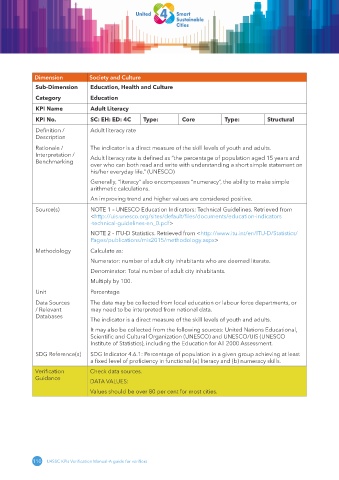Page 120 - U4SSC KPIs Verification Manual - A guide for verifiers
P. 120
Dimension Society and Culture
Sub-Dimension Education, Health and Culture
Category Education
KPI Name Adult Literacy
KPI No. SC: EH: ED: 4C Type: Core Type: Structural
Definition / Adult literacy rate
Description
Rationale / The indicator is a direct measure of the skill levels of youth and adults.
Interpretation / Adult literacy rate is defined as “the percentage of population aged 15 years and
Benchmarking
over who can both read and write with understanding a short simple statement on
his/her everyday life.” (UNESCO)
Generally, “literacy” also encompasses “numeracy”, the ability to make simple
arithmetic calculations.
An improving trend and higher values are considered positive.
Source(s) NOTE 1 – UNESCO Education Indicators: Technical Guidelines. Retrieved from
<http:// uis .unesco .org/ sites/ default/ files/ documents/ education -indicators
-technical -guidelines -en _0 .pdf>
NOTE 2 - ITU-D Statistics. Retrieved from <http:// www .itu .int/ en/ ITU -D/ Statistics/
Pages/ publications/ mis2015/ methodology .aspx>
Methodology Calculate as:
Numerator: number of adult city inhabitants who are deemed literate.
Denominator: Total number of adult city inhabitants.
Multiply by 100.
Unit Percentage
Data Sources The data may be collected from local education or labour force departments, or
/ Relevant may need to be interpreted from national data.
Databases
The indicator is a direct measure of the skill levels of youth and adults.
It may also be collected from the following sources: United Nations Educational,
Scientific and Cultural Organization (UNESCO) and UNESCO/UIS (UNESCO
Institute of Statistics), including the Education for All 2000 Assessment.
SDG Reference(s) SDG Indicator 4.6.1: Percentage of population in a given group achieving at least
a fixed level of proficiency in functional (a) literacy and (b) numeracy skills.
Verification Check data sources.
Guidance
DATA VALUES:
Values should be over 80 per cent for most cities.
110 U4SSC KPIs Verification Manual-A guide for verifiers

